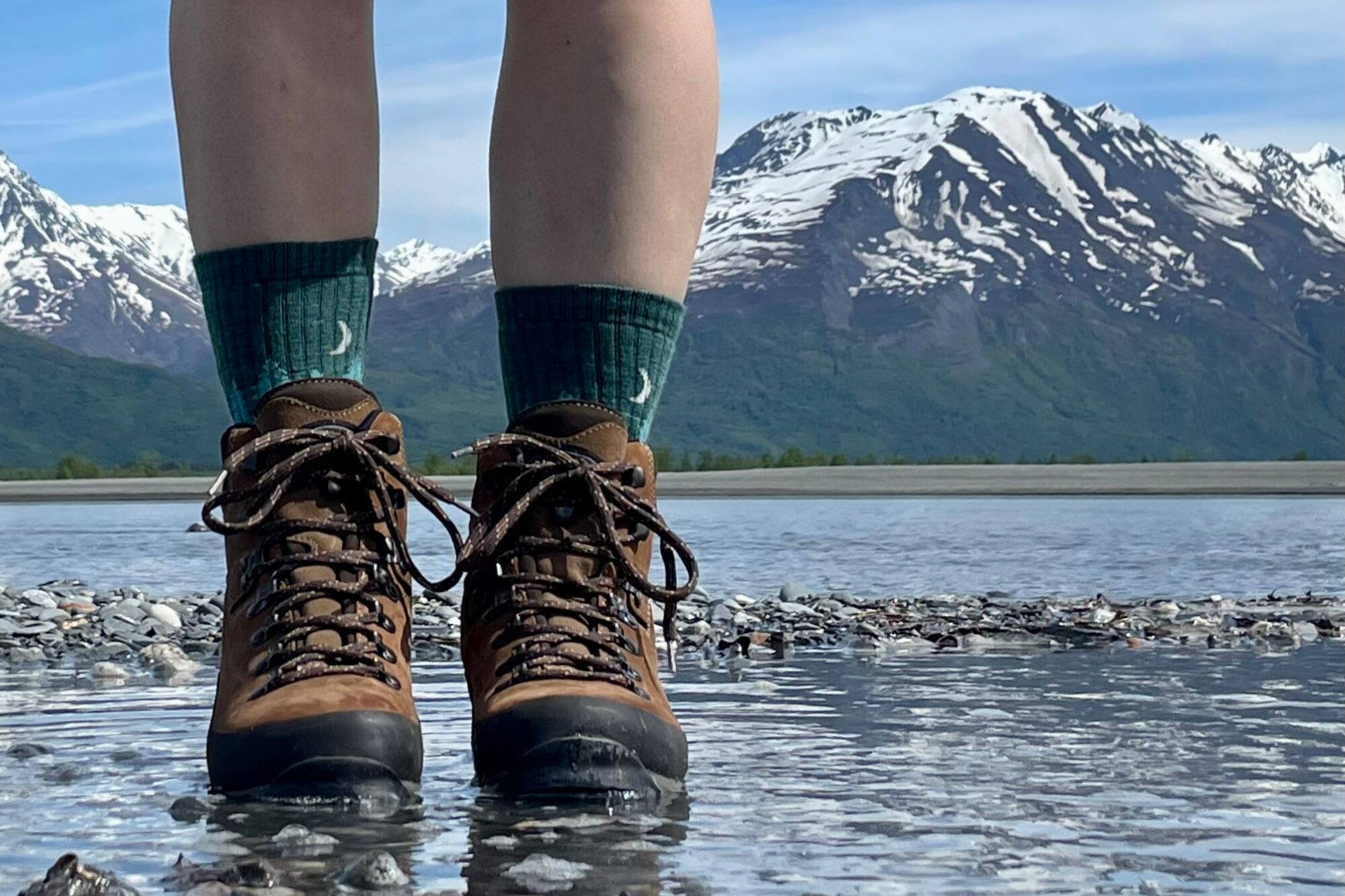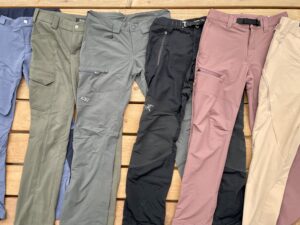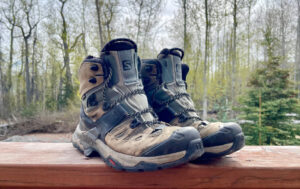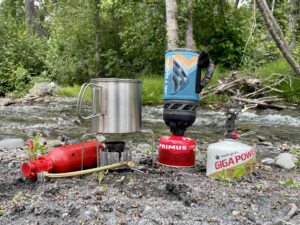Hiking socks are a critical piece of outdoor gear. While you may be tempted to grab any old pair out of your sock drawer for your next day out, good hiking socks provide comfort, cushioning, and moisture-wicking that your daily socks can’t. They are vital to keeping your feet healthy during long hikes.
To find the best pair of hiking socks, Gear Editor Chelsey Cook and Sam Anderson put dozens of socks to the test, wearing some pairs until they literally came apart at the seams. They hiked and backpacked in the Southwest desert and Alaskan tundra, testing the socks in sand and snow alike and on hard-packed trails and river crossings. Chelsey wore a few pairs for over a week straight while on backpacking trips throughout Alaska to evaluate their durability and odor control, and tested toesocks while running an ultramarathon. She also packed three pairs for a month of travel in Peru, to test how they held up to repeated daily abuse of wandering the streets of Cusco and hiking throughout the Sacred Valley.
Throughout our testing, we considered durability, cushioning, and comfort. We tested socks made from different materials, with different heights and cushioning levels. This guide represents the hiking socks that kept our feet the happiest during long days on the trail.
If you’re looking for a pair of boots to go with your hiking socks, check out our guide to The Best Hiking Boots of 2024.
Editor’s Note: We updated this guide on May 29, 2024, to announce our Best Overall Hiking Socks as the Darn Tough Hiker Micro Crew Cushion Hiking Socks. We also added superlatives for Best Hiking Socks for Cold Weather and Best Hiking Socks to Prevent Blisters.
Our Picks for the Best Hiking Socks
- Best Overall Hiking Socks: Darn Tough Hiker Micro Crew Cushion Hiking Socks
- Best Lightweight Hiking Socks: Farm to Feet Max Patch 1/4 Lightweight Hiking Socks
- Best Hiking Socks for Cold Weather: Smartwool Ski Targeted Cushion Over the Calf Socks
- Best Hiking Socks to Prevent Blisters: Injinji Trail Midweight Socks
Best Overall Hiking Socks:
Darn Tough Hiker Micro Crew Cushion Hiking Socks
Features: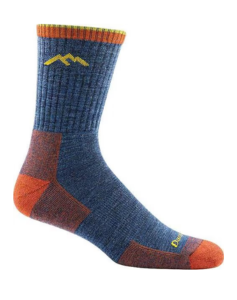
- Responsibly sourced merino wool insulates even when wet
- Well-established reputation for long-term durability, coupled with a lifetime warranty
- Micro crew height works with most hiking boots
- Made in Vermont
- Favorite of thru-hikers
Why we like them: Incredible durability with a lifetime warranty, very comfortable
What we don’t like: Expensive, may be too warm for hiking in hot climates
Materials: 61% merino wool, 36% nylon, 3% lycra spandex | Height: Micro crew | Weight: Midweight
The Darn Tough Hiker Micro Crew Cushion Hiking Socks ($25) are Sam’s and Chelsey’s pick for their favorite overall hiking socks. Both Sam and Chelsey have (regrettably) spent weeks in the backcountry with only one or two pairs of socks, and Darn Toughs were the only ones to stand up to the job. The merino wool keeps odor at bay while also providing insulation, and the cushioning is comfortable even after long days on your feet. The height and cushioning level also makes them ideal for a range of activities, including hiking, biking, scrambling, and packrafting.
They’re also ridiculously durable. Despite using them for all of her hiking, trail running, and daily sock needs, Chelsey has never managed to wear a hole in any of her pairs, though the elastic ankle has occasionally stretched out after a few seasons of use. Luckily, with Darn Tough’s Guaranteed for Life program, Chelsey has just mailed her old, worn-out socks to the Vermont-based company, and they’ve sent her a new pair or a gift card in exchange. This makes the upfront $25 cost easier to swallow.
Some hikers may find them a little too warm for hot days or hard efforts. Thankfully, Darn Tough also has Light Hiker Micro Crew Socks, which Chelsey uses for trail running.
Check Men’s Price at Backcountry
Check Women’s Price at Backcountry
Best Lightweight Hiking Socks:
Farm to Feet Max Patch 1/4 Lightweight Hiking Socks
Features: 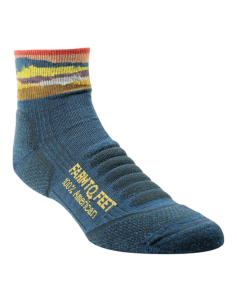
- Supply chain is entirely within the U.S.
- Targeted, light cushion keeps socks comfortable and lightweight
- Seamless toe closure reduces bulk and friction
- Aesthetic mountain pattern around the ankle
Why we like them: Supportive and lightweight, with cushioning in all the right places
What we don’t like: Low height may not work with most traditional hiking boots, not as durable as Darn Toughs
Materials: 59% nylon, 37% merino wool, 4% spandex | Height: Ankle | Weight: Lightweight
The Farm to Feet Max Patch 1/4 Lightweight Hiking Socks ($22) are above-the-ankle hiking socks with targeted cushioning to keep them lightweight. The socks are made with 100% U.S.-sourced merino wool, as well as American nylon and spandex, and feature a comfortable seamless toe closure to reduce bulk and blisters. High-density cushioning is focused only along the ball, heel, and top of your foot, to let your feet breathe in warmer conditions. The Max Patch socks also only reach just above your ankle bone. While this helps keep you cool during hot hikes, the low height can cause some rubbing in traditional hiking boots. These socks are best worn with hiking shoes, mid-height hiking boots, and trail runners.
Chelsey found the Farm to Feet socks less durable than Darn Toughs, likely because of the thinner material. However, Farm to Feet also has a Satisfaction Guarantee program that lets you send back socks if you aren’t happy with their durability.
Best Hiking Socks for Cold Weather:
Smartwool Ski Over the Calf Targeted Cushion Sock
Features: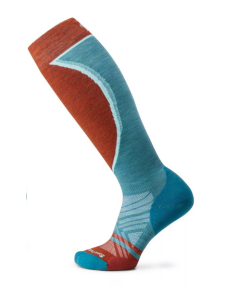
- Over the calf height keeps your lower legs warm
- Targeted cushion to protect your feet without making the socks bulky
- Mesh zones increase breathability
- Indestructawool™ technology enhances durability
What we like them: Durable, warm without being bulky, merino wool for odor control
What we don’t like: Shin cushioning is unnecessary for hiking and may make the socks too warm for some conditions
Materials: 59% merino wool, 27% recycled nylon, 3% elastane | Height: Over the calf | Weight: Midweight
The Smartwool Ski Over the Calf Targeted Cushion Socks ($28) is Chelsey’s pick for the best hiking socks for cold weather and winter hikes. The high, over-the-calf length provides ample coverage to keep your feet and lower legs warm, while the targeted cushion in the balls and heels will make those long days on your feet more enjoyable. The targeted cushion also keeps the socks slim enough to fit in hiking boots without squishing your toes. Like the Darn Tough Hiker Micro Crew Cushion Hiking Socks, the Smartwool Ski Socks have a high percentage of merino wool, making the socks softer and more odor-resistant than other materials.
While the shin cushioning isn’t necessary for hiking, it may help keep your legs warmer and make the socks more versatile. Chelsey uses the same pair for winter hiking and backcountry skiing. Smartwool also offers the same socks with full cushion and zero cushion.
Check Men’s Price at Smartwool
Check Women’s Price at Smartwool
Best Hiking Socks to Prevent Blisters:
Injinji Trail Midweight Socks
Features:
- Mesh top for breathability
- Each toe is protected to reduce skin-on-skin friction and lets your foot splay naturally
- Band around the arch increases support
- Extra cushioning on the footbed
Why we like them: The best blister-prevention out there, light enough for hot days
What we don’t like: Toe-socks aren’t for everyone, elastic in the ankle stretches out
Materials: 39% CoolMax EcoMade, 58% nylon, 3% lycra | Height: Crew | Weight: Midweight
While the Injinji Trail Midweight Socks ($17) may look a little ridiculous, toesocks are incredibly popular amongst ultrarunners, and for a good reason. These socks are blister–preventing wonders. With each toe individually protected by its own sock, skin-on-skin friction, one of the main causes of blisters, is essentially eliminated. Chelsey tested them for herself throughout several long training runs and ultramarathons and walked away without a single blister. Having each toe separated also lets her feet splay and move naturally in her shoes, reducing the usual pain she feels in her forefoot on long runs and hikes. The mesh top kept her feet from overheating, while the arch band supported her on long days.
While the feeling of fabric between your toes takes time to get used to, it’s well worth it for how happy your feet will be after a long hike or run. Injinji also offers mini-crew and ankle socks if you prefer a shorter sock.
Check Women’s Price at Injinji
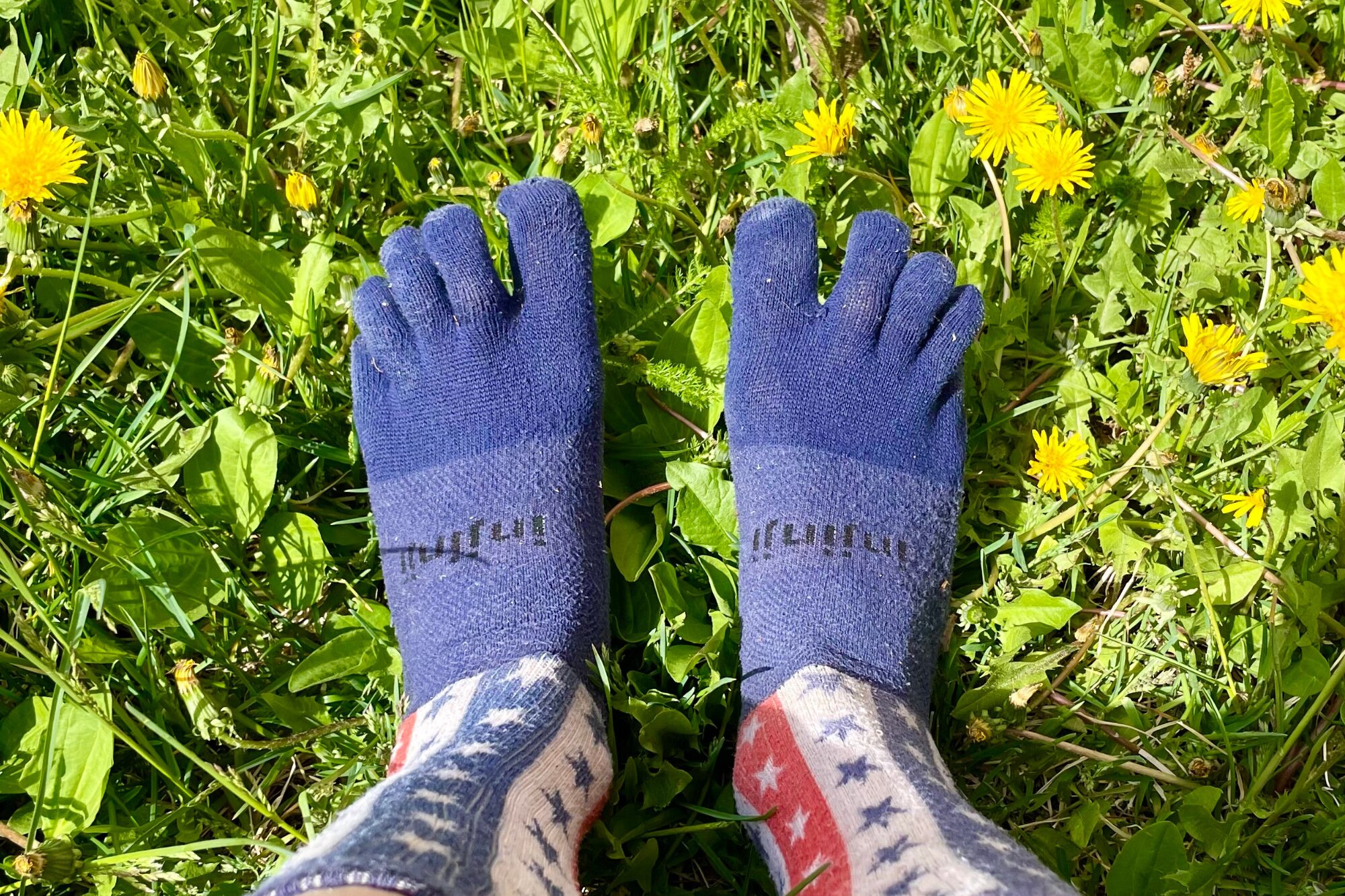
Toesocks may look strange, but this pair saw Chelsey through several ultras blister-free. Photo: Chelsey Cook.
About our testing process
The ExplorersWeb sock testing team, comprised of Chelsey Cook and Sam Anderson, has worn through so many socks during their collective 35 years of backpacking, climbing, and mountaineering that they’ve lost count. They gladly took on the challenge of testing a batch of new hiking socks to determine which pairs should be included in this guide.
Sam Anderson started this guide in May 2022. He’s a jack of all trades — an avid road tripper and passionate rock climber, and a chainsaw operator and carpenter. Whether he’s working or playing, he’s on his feet and more often than not in boots. Sam relies on the right hiking socks to keep his feet comfortable and prioritizes socks made from moisture-wicking and odor-controlling materials. He tested socks on backpacking and rock climbing trips along the West Coast,
Gear Editor Chelsey Cook took over the hiking socks guide in May 2024. As a mountaineering and backpacking guide in Alaska, she often spends at least four months a year in the field. With an average pack weight over 75 pounds on most expeditions, she cuts weight and bulk where she can, and typically flies into the backcountry with only two pairs of socks to cover her for up to three weeks.
Because she demands so much from each pair, Chelsey values durability, adequate cushioning, and comfort. She’s a die-hard Darn Tough fan, exclusively wearing them for all her backpacking and mountain biking needs, and in her daily life. She also tested cold-weather hiking socks while backcountry skiing in France and Washington, and on mountaineering trips in the Alaska Range. She brought the Smartwool Ski Over the Calf Targeted Cushion Socks on Denali, running the socks through their paces for three weeks. Lastly, because she’s a glutton for recreational discomfort, Chelsey signed up for a 250-mile ultramarathon in Utah and wore the Injinji Trail Midweight Socks for the first 120 miles. While the rest of her body fell apart, her feet did not, and she walked away from the race without a single blister.
To meet a wide range of hiking needs, we included socks with different heights and cushioning in this guide. All the socks in this guide meet our standards for durability, comfort, and support. They’re also all from trusted brands, many of which have outstanding warranty programs.
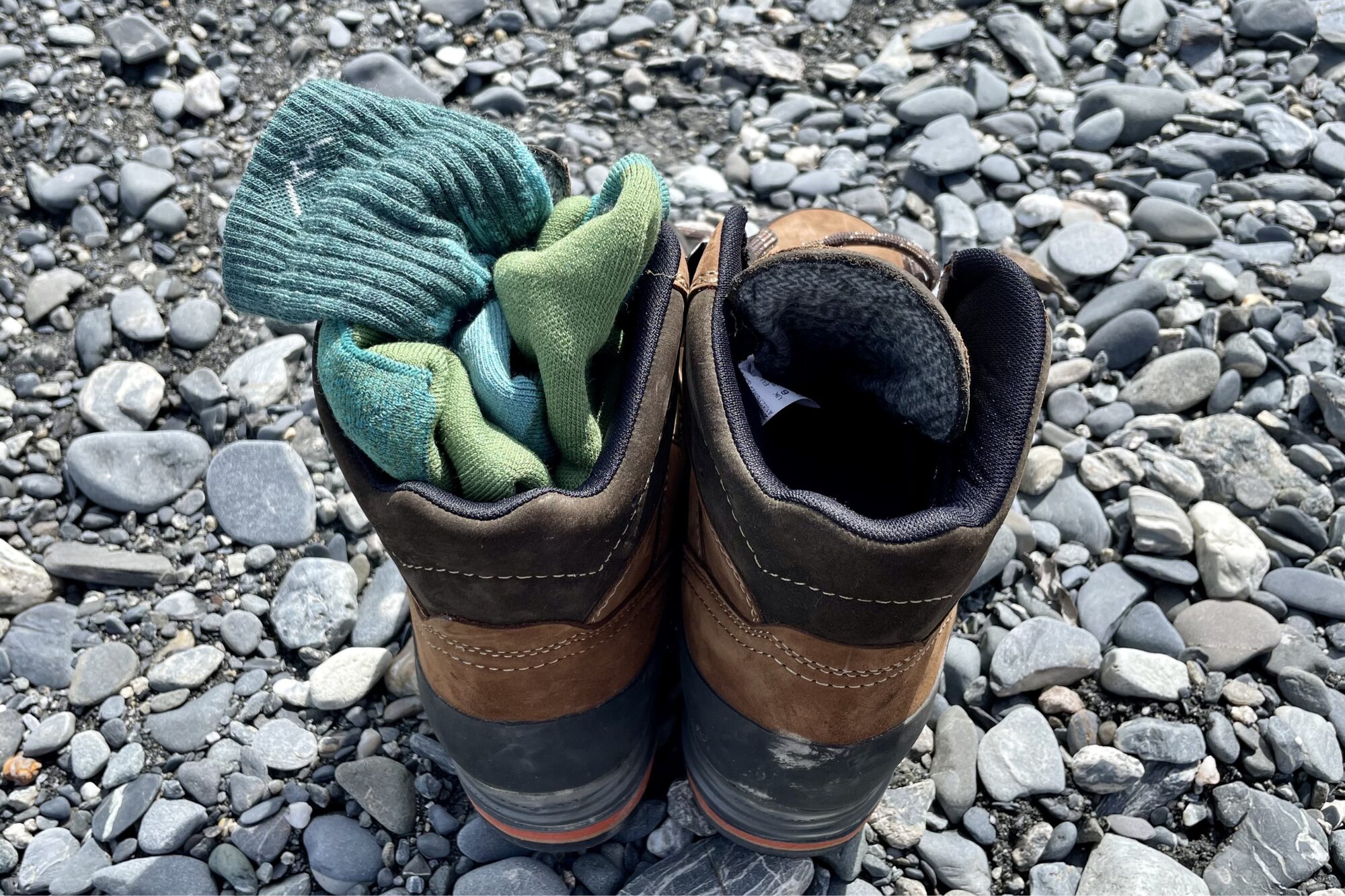
A pair of Darn Toughs stuffed in a boot during a lunch break. Photo: Chelsey Cook.
Things to consider in hiking socks
Materials
The hiking socks market is filled with wool socks and for good reason. Wool regulates temperature and wicks moisture, helping prevent sweaty feet. It insulates when wet, a property that Chelsey appreciates in Alaska, where every hike seems to include a river crossing. Wool also naturally reduces odor.
Most wool socks come in a blend of fibers, including a synthetic material like nylon and a stretchy one like spandex. Merino wool is typically softer and less itchy than regular wool. Look for brands that source their merino wool responsibly.
Some hiking socks, particularly liner socks, are made from polyester, a synthetic material. Polyester socks are affordable, light, and quick-drying. Polyester isn’t as breathable or soft as wool and tends to get stinky quicker. It’s also a synthetic material derived from petroleum, so not as sustainable as natural wool.
Height
Hiking socks come in all different heights, from no-show to over the calf and everything in between. The right height depends on your footwear. The higher your boots, the taller your socks should be to prevent the boots from rubbing your skin
- No-show: These socks are so short that they won’t show over the top of a running shoe. They offer your ankles no protection from abrasions, either from your hiking boots or from brush. We didn’t include any in this buyer’s guide, but they can be a good option for trail running shoes.
- Ankle: Also called 1/4 crew, these hiking socks come just above your ankle bone. While too short for traditional hiking boots, Chelsey often wears them with running shoes and likes the Farm to Feet Max Patch 1/4 Lightweight Hiking Socks.
- Crew: This is the most common height for hiking socks. They extend a few inches above your ankle bone, protecting your skin from higher-cuffed hiking boots and brushy trails.
- Over the calf: These socks come to just below the knee, and are often labeled as ski socks rather than hiking socks. They provide maximum abrasion protection and warmth and are a good option for winter hiking and mountaineering.
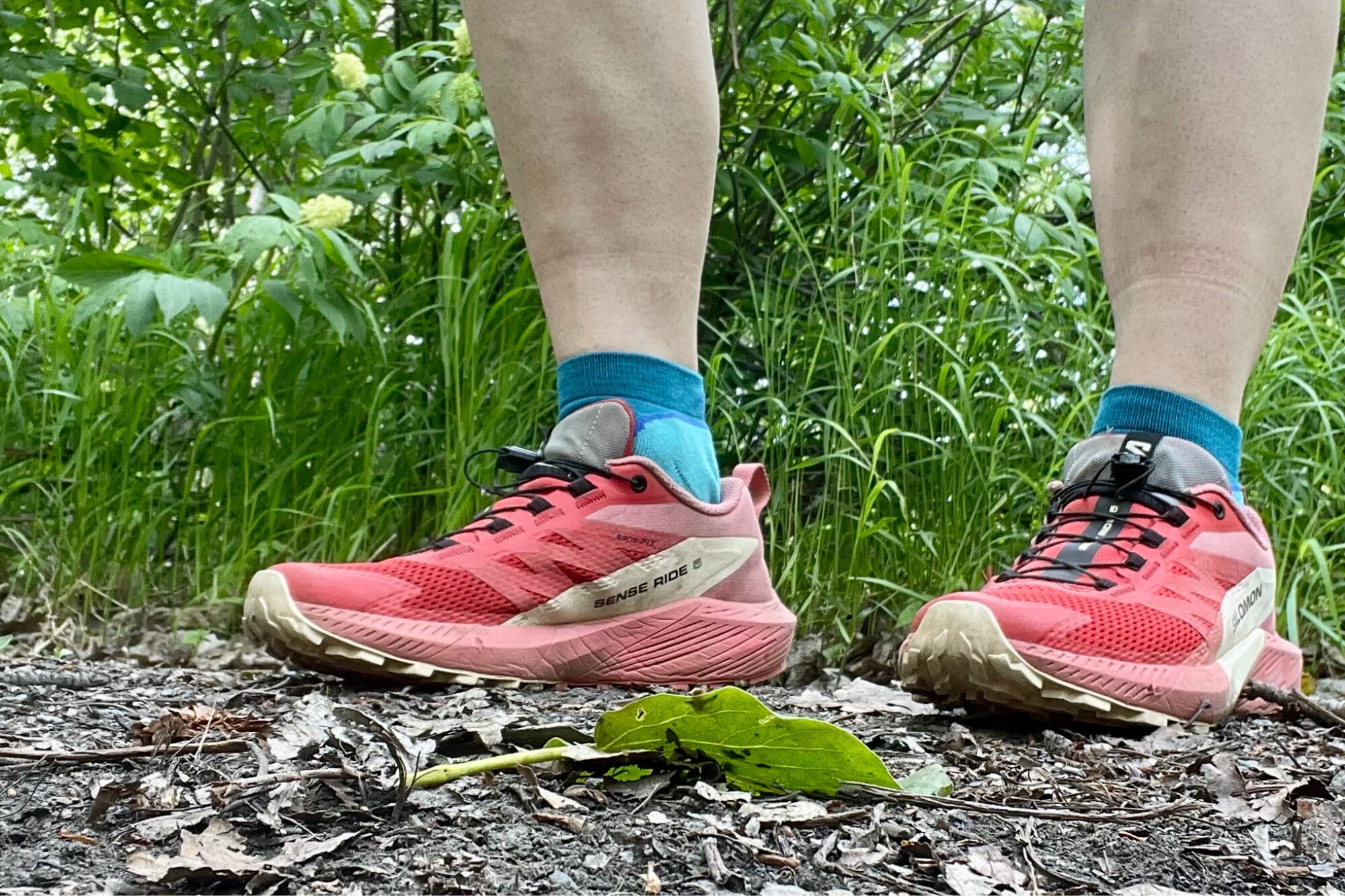
Ankle socks are a great option for trail running shoes. Photo: Chelsey Cook
Cushioning
The amount of cushioning in hiking socks affects their thickness, warmth, and comfort.
- No cushioning: Hiking socks with no cushioning are lightweight and breathable. These socks can be a good option for hot day hikes, but your feet may suffer on longer trips without any cushioning.
- Light cushioning: Made for warmer conditions, these socks are lightweight, with cushioning only in a few key areas, like the balls and heels of the feet. Light cushioning is sometimes called targeted cushioning, like in the Farm to Feet Max Patch 1/4 Lightweight Hiking Socks.
- Medium cushioning: These socks have cushioning on the balls and heels, and sometimes the entire footbed. They’re a great choice for moderate to cooler temperatures, and the increased cushioning will keep your feet happier on longer days or under heavy packs. Chelsey uses medium cushioning on her backpacking trips and long day hikes.
- Heavy cushioning: These socks are the thickest and warmest available. They’re designed for winter conditions and mountaineering and aren’t suitable for most backpacking trips. Chelsey brings a pair of heavy-cushioned socks on Denali for summit day, and to use as her “sleep socks”. They’re generally too thick to fit comfortably in her hiking boots.
Durability
Between long days on the trail, dealing with sweat and dirt, and then being put through the wash cycle, hiking socks go through a lot of wear and tear over their lifespan. You want your hiking socks to last you several seasons of adventure, and durability is a key component to hiking socks choice. While all the brands in this buyer’s guide make high-quality socks, some are more durable than others. For instance, Chelsey found that Smartwool hiking socks are prone to holes. The ankles on her Injinji’s also stretched out quickly, though the rest of the socks held up well. Darn Toughs, while not the softest and lightest hiking socks, truly live up to their name. Chelsey has not yet managed to wear a hole in them, though she has noticed the ankles loosening after a year of heavy, almost daily use — which is frankly more abuse than any single pair of socks should bear.
Some brands, like Farm to Feet and Darn Tough, have warranty programs. Farm to Feet’s Satisfaction Guarantee Program lets you send back socks that don’t meet your durability and performance standards in exchange for new ones. Darn Tough’s Guaranteed for Life program similarly lets you send back worn-out socks in exchange for a new pair. Chelsey’s sent in Darn Tough socks with stretched-out ankles and thin heels and appreciates how quick and easy the program is.
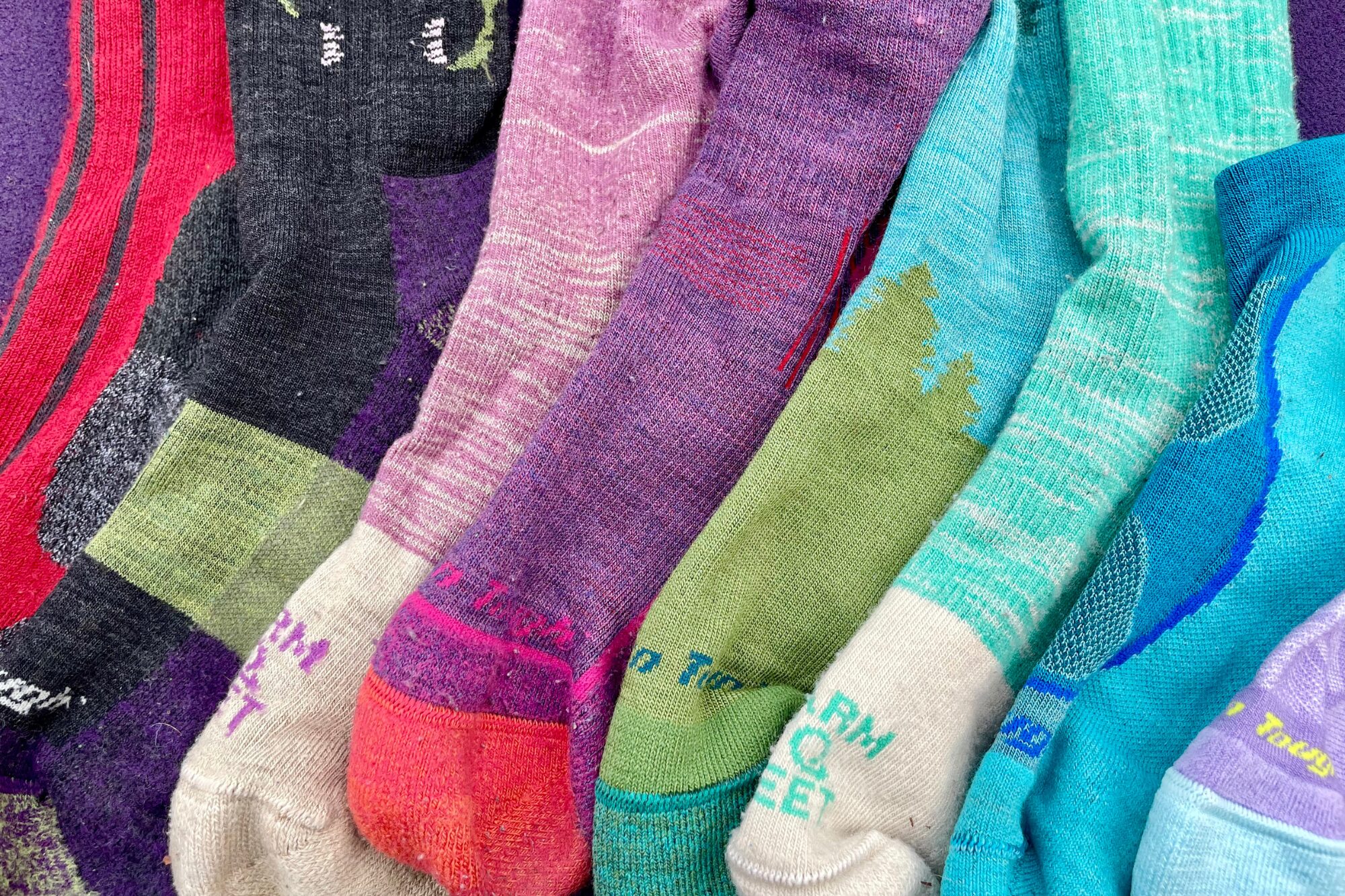
Some of the socks Chelsey tested. Photo: Chelsey Cook.
Frequently asked questions
What materials are best for hiking socks?
Wool is the best material for hiking socks. Wool wicks moisture and insulates while wet, and provides cushioning for your feet. Most hiking socks come in a blend of wool, nylon, and an elastic material like lycra. Polyester is also sometimes used, but it doesn’t have the same odor control as wool does.
What are the best hiking socks?
Our pick for the best hiking socks are the Darn Tough Hiker Micro Crew Cushion Hiking Socks. We loved how comfortable and cushioned they were, with a height that comfortably fits with most hiking boots. Darn Tough also has an impeccable lifetime warranty for their socks, making them our best-value choice as well.
Are thick or thin socks better for hiking?
It depends on the climate you’re hiking in, your personal preference, and the type of hiking boots you’re using. Thicker socks offer more cushioning, which might be more comfortable if you’re wearing traditional hiking boots, carrying a heavy backpack, or will be spending long hours on your feet. However, they are also warmer and bulkier, which can be uncomfortable on hot days. Thinner socks don’t offer as much cushioning but can be a good option if you use light hiking shoes or trail running shoes, or are going on day hikes in hotter weather. Whatever socks you choose, make sure they fit comfortably in your shoes and don’t cram your toes. The thicker the sock, the more room in your shoe it will take up!
Should I wear liner socks?
Liner socks, thin socks you wear under your hiking socks, were once a popular method to help wick moisture and keep your feet dry. Most hiking socks on the market today, particularly those made of merino wool, have such high moisture-wicking performance that you don’t need liner socks. Some hikers also use liner socks to help prevent blisters. If your feet are blister-prone, it may be worth trying, though we recommend trying the Injinji Trail Midweight Socks first.
